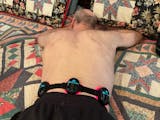Unveiling the Science Behind Red Light Therapy for Post-COVID Hair Loss
The aftermath of the COVID-19 pandemic has led to many individuals grappling with a range of lingering symptoms, among which hair loss is a distressing concern. As researchers delve deeper into the underlying mechanisms of post-COVID hair loss, innovative therapeutic modalities are being explored to address this pressing issue. Red light therapy, with its non-invasive nature and potential to modulate biological processes, has emerged as a frontrunner in the quest for effective treatments.
Understanding Post-COVID Hair Loss: A Complex Interplay of Factors
Telogen effluvium (TE), commonly known as post-COVID hair loss, is a condition where there is an abnormal amount of hair shedding caused by disruptions in the hair growth cycle. The specific cause of post-COVID TE is still unknown, but recent research suggests that it is likely a result of various factors working together. These factors include immune dysregulation, the presence of inflammatory cytokines, and changes in the microvasculature. The systemic inflammation caused by COVID-19 can potentially trigger an abnormal immune response, which in turn leads to the miniaturization of hair follicles and premature shedding.
Unraveling the Mechanisms of Red Light Therapy
Red light therapy, also referred to as low-level laser therapy (LLLT) or photobiomodulation, utilizes particular wavelengths of light to activate cellular activity and promote tissue repair. The key aspect of red light therapy is its capacity to deeply penetrate the skin and regulate cellular processes at the molecular level. This involves activating mitochondrial respiratory chain complexes, increasing the production of antioxidant enzymes, and adjusting the levels of inflammatory mediators like cytokines and nitric oxide.
The Promise of Red Light Therapy in Post-COVID Hair Loss
Red light therapy is emerging as a promising solution for post-COVID hair loss, offering a safe and effective therapeutic approach. By targeting key pathways involved in hair follicle function and regeneration, red light therapy provides a multifaceted strategy for promoting hair regrowth. Scientific studies have shown that this therapy can stimulate the proliferation of dermal papilla cells, increase the production of growth factors, and prolong the anagen phase of the hair growth cycle.
Clinical Evidence and Insights
Clinical trials investigating the effectiveness of red light therapy in treating hair loss after COVID-19 have produced promising outcomes. Individuals who have undergone red light therapy have observed a decrease in hair shedding, an increase in hair density, and an overall enhancement in hair quality. Trichoscopic assessments have unveiled alterations that suggest improved follicular activity, such as an augmentation in hair shaft thickness and the existence of anagen hairs. It is noteworthy that the advantages of red light therapy extend beyond hair rejuvenation, as patients have reported enhancements in scalp health and their overall state of being.
Navigating the Future of Post-COVID Hair Loss Treatment
In the intricate realm of post-COVID hair loss treatment, red light therapy emerges as a promising solution for those impacted. With its non-invasive approach, limited adverse reactions, and capacity to address fundamental pathophysiological processes, it presents an appealing choice for both medical professionals and patients. To enhance treatment strategies, investigate synergistic treatments, and comprehend the complex molecular mechanisms supporting the therapeutic benefits of red light therapy, additional research is imperative.
Conclusion: Empowering Individuals on the Road to Hair Recovery
In the aftermath of the COVID-19 pandemic, it is crucial to focus on finding effective treatments for post-COVID hair loss. Red light therapy is a modern approach that offers real benefits for individuals experiencing hair loss after the virus. By bridging the gap between scientific knowledge and clinical application, red light therapy has the potential to revolutionize the field of hair restoration, helping individuals regain their confidence and quality of life.
















Share:
Muscle Recovery Acceleration: Evidence Supporting Red Light Therapy
Muscle Recovery Acceleration: Evidence Supporting Red Light Therapy